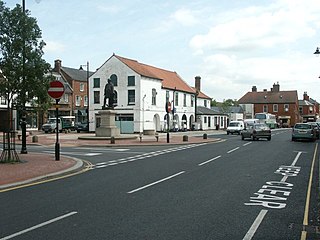King Edward's School or King Edward VI School may refer to:

Spilsby is a market town, civil parish and electoral ward in the East Lindsey district of Lincolnshire, England. The town is adjacent to the main A16, 33 miles (53 km) east of the county town of Lincoln, 17 miles (27 km) north-east of Boston and 13 miles (21 km) north-west of Skegness. It lies at the southern edge of the Lincolnshire Wolds and north of the Fenlands, and is surrounded by scenic walking, nature reserves and other places to visit.

Grimsthorpe Castle is a country house in Lincolnshire, England 4 miles (6.4 km) north-west of Bourne on the A151. It lies within a 3,000 acre (12 km2) park of rolling pastures, lakes, and woodland landscaped by Capability Brown. While Grimsthorpe is not a castle in the strict sense of the word, its character is massive and martial – the towers and outlying pavilions recalling the bastions of a great fortress in classical dress. Grimsthorpe has been the home of the de Eresby family since 1516. The present owner is Jane Heathcote-Drummond-Willoughby, 28th Baroness Willoughby de Eresby, granddaughter of Nancy Astor, who died at Grimsthorpe in 1964.
King Edward VI Grammar School is a grammar school located in Louth, Lincolnshire, England.

Peregrine Bertie, 13th Baron Willoughby de Eresby was the son of Catherine Willoughby, 12th Baroness Willoughby de Eresby, and Richard Bertie. Bertie was Lady Willoughby de Eresby's second husband, the first being Charles Brandon, Duke of Suffolk. Peregrine Bertie's half-brothers, Henry and Charles Brandon, died as teenagers four years before his birth. His sister Susan married the Earl of Kent and then the nephew of Bess of Hardwick. Owing to religious politics, the parents had to move outside England and the boy was born at Wesel on the River Rhine.
Lincolnshire is one of the few counties within the UK that still uses the eleven-plus to decide who may attend grammar school, in common with Buckinghamshire and Kent.

Firsby is a small rural linear village and civil parish in the East Lindsey district of Lincolnshire, England. It is situated 30 miles (48 km) east from the city and county town of Lincoln, 4 miles (6.4 km) south-east from the nearest market town of Spilsby, and 7 miles (11 km) inland from the holiday resort town of Skegness.

King Edward VII Academy is a large, mixed comprehensive secondary school in Gaywood Road (A148), King's Lynn, Norfolk, England with around 1,300 pupils, including about 300 in sixth form education. Prior to the school year beginning in September 1979, KES was an all-boys state grammar school.
Cordeaux Academy was a coeducational secondary school and sixth form with academy status, located on North Holme Road in Louth, Lincolnshire, England.

The King's School is a British grammar school with academy status, in the market town of Grantham, Lincolnshire, England. The school's history can be traced to 1329, and was re-endowed by Richard Foxe in 1528. Located on Brook Street, the school's site has expanded over the course of its history, with some school buildings dating back to 1497.
Formal education in Sheffield, England, takes place at the city's two universities, 141 primary schools and 28 secondary schools.
Sir James Smith's School is a coeducational secondary school located in the town of Camelford, North Cornwall, England. The headteacher is Kristien Carrington.
King Edward VI School is a co-educational comprehensive secondary school in Bury St Edmunds, Suffolk, England. The school in its present form was created in 1972 by the merging of King Edward VI Grammar School, with the Silver Jubilee Girls School and the Silver Jubilee Boys School. The school occupies the site of the former Silver Jubilee schools in Grove Road, Bury St Edmunds.
King Edward VI High School is a coeducational secondary school and sixth form located in the Highfields area of Stafford, England. The school's sixth form forms part of the Stafford Collegiate. It is a non-selective state school admitting boys and girls from ages 11–18. The school was formed in 1977 following the amalgamation of King Edward VI Boys’ Grammar School and Stafford Girls’ High School.
King Edward VI Community College (KEVICC) is a coeducational secondary school and sixth form located in Totnes, Devon, England. It is located in the Dart Valley on the A385 Ashburton Road and serves Totnes and the surrounding area. It has a large campus with around 900 students, 200 of whom are at the Kennicott Sixth Form centre adjoining the main site.

Charles Read Academy is a co-educational secondary school located in Corby Glen, Lincolnshire, England. It serves the villages between Stamford, Bourne and Grantham.

The Howard School is a boys' secondary school in Rainham, Kent, England, with approximately 1,500 pupils. It offers a partially selective system and is one of only five bi-lateral schools in the United Kingdom. The partially selective system permits admission to the grammar school section by the 11-Plus selection, however a passing mark is not required if the pupil is seen to have the ability to work in the 'grammar stream', and non-selective admission to the high school. The school is a Sports College.
Nancy Jane Marie Heathcote-Drummond-Willoughby, 28th Baroness Willoughby de Eresby, is an English peer and member of the Astor family. She is a 1⁄4 holder of the office of Lord Great Chamberlain, which is exercised by the 7th Baron Carrington.
Retford King Edward VI Grammar School was a grammar school opened on London Road, Retford, Nottinghamshire, in 1857, after being moved from an older site in Chapelgate. The school closed down in 2003.

The Old Town Hall is a municipal building in the High Street in Spilsby, Lincolnshire, England. The structure, which accommodates some shops and a petrol filling station, is a Grade II listed building.












